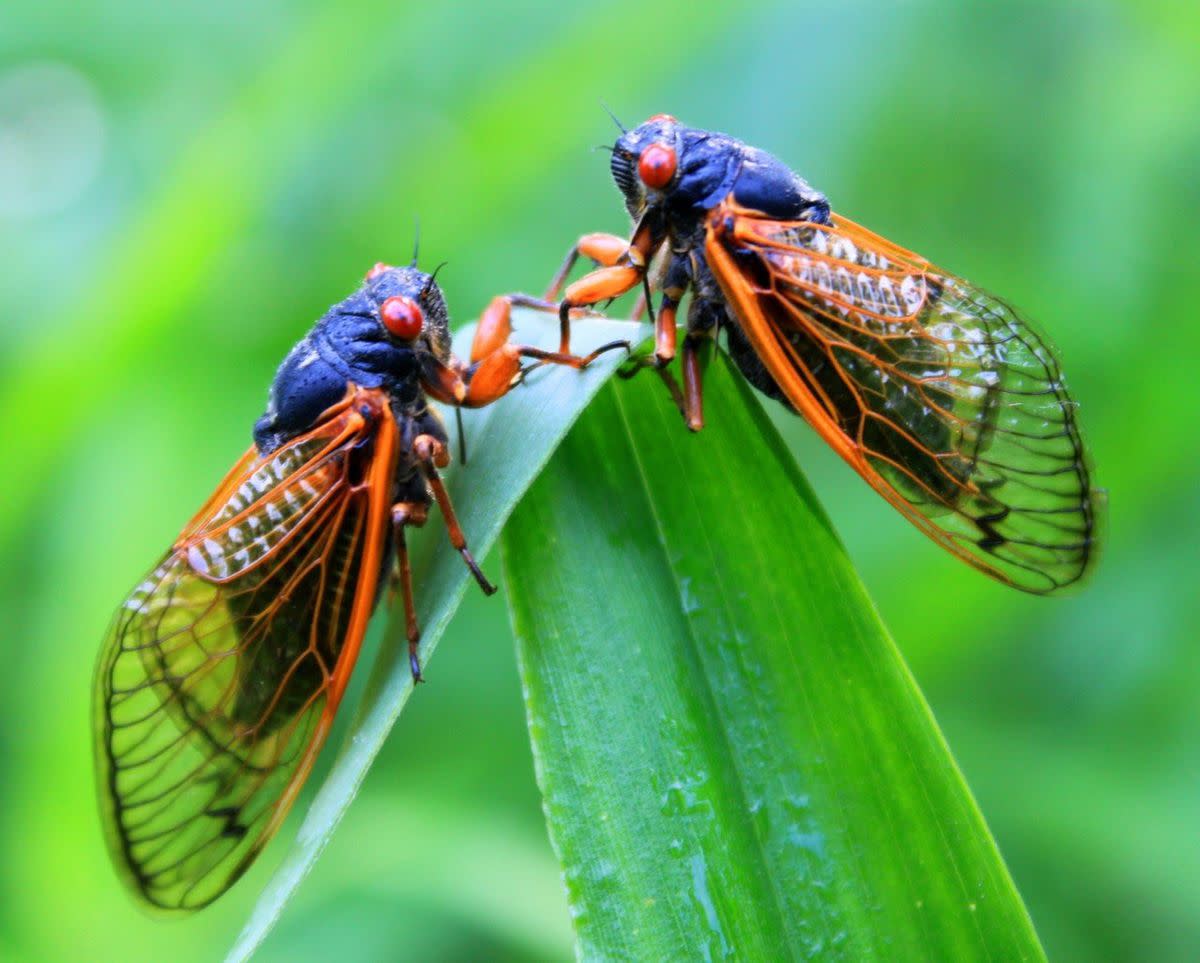Whether you find cicadas fascinating or unsettling, there’s usually one unsettling thought: What will my yard look like without them?
Thinking about the widespread appearance of insects like cicadas makes one wince. Millions of them can be found on a single acre, producing an almost unbearable buzzing noise. Thus, it makes sense that queries such as “Will cicadas eat my plants?” instantly come to mind. However, cicadas are also fascinating and essential to the ecosystem.
This is a summary of the beneficial and bad things about cicadas, such as whether or not they devour plants and how to keep your trees safe during their emergence.
On This Page
A Cicada: What Is It?
Insects known as cicadas have large bodies and up to a three-and-a-half-inch wingspan. “You can recognize them by their wide-open, prominent eyes, transparent, veined wings, and the loud, characteristic song of the males,” says Butterfly Pavilion Vice President of Education Shartrina White.
Cicadas are members of the order Hemiptera, which includes a class of insects known as genuine bugs. Aphids, planthoppers, and assassin bugs are among the others in that group that feed on plants by puncturing and sucking their mouthparts.
When Are Cicadas Found Outside?
Yes, it depends on the species. The most well-known are the periodic cicadas, which appear between April and June approximately every 13 to 17 years. However, every year, between July and September, other cicadas arise.
According to Daniel A. Herms, vice president of research and development at The Davey Tree Expert Company, “soil temperature can affect emergence.” “Adult cicadas emerge when the soil temperature reaches approximately 64°F at a depth of about eight inches.”
What Consume Cicadas?
Cicadas’ young, underground stage, known as nymphs, consumes fluids from tree roots. Adult cicadas will occasionally consume plants, sucking sap from deciduous shrubs, young trees, and fragile twigs.
Do Cicadas pose a danger to the plants in your landscape and garden?
Maybe. Cicadas bore holes in tiny twigs and branches where they deposit their eggs. In addition to causing aesthetic harm, this can harm young deciduous trees.
Herms claims that “it can cause the flagging [breaking] of foliage in the canopy by killing the tiny twigs and leaves at the tips of branches.” “Though this minor pruning of a comparatively small number of twigs has minimal effect on healthy, mature plants, tufts of dead foliage may appear alarming.”
However, cicadas generally ignore most herbaceous plants, including garden plants, fruit, and mature trees. Furthermore, neither the nymphs that feed underground nor the eggs they lay in shrubs, grasses, or wildflowers endanger the plants’ health.
How to Prevent Cicadas from Getting Near Trees
Cover small, recently planted trees with cheesecloth or fine mesh netting before they emerge. Make sure to securely fasten it around the trunk to prevent cicadas from scaling the branches.
According to Marc Mayer, Director of Technical Operations at TruGreen, “Say no to insecticides, as they can make matters worse by getting rid of the cicadas’ natural predators.” “If you see cicadas camped out on your plants, water them with a garden hose to prevent them from devouring them.”
Aside from covering outdoor pools to discourage cicadas from destroying the filter, don’t plant new trees the year before a significant breakout is predicted.
“To promote new growth, prune away branches that appear significantly damaged as soon as egg-laying is complete, which is usually within a few weeks,” advises Herms. “Remember that cicadas have more advantages than drawbacks.”
Why are cicadas beneficial?
A wonderful deal. Many animal species, including birds, chipmunks, foxes, raccoons, squirrels, mice, and other insects like the magnificent, huge cicada killer wasp, which carries cicadas into its underground nest to feed its young, eat insects like cicadas, according to Hopwood.
Both adult and juvenile cicadas contribute to soil aeration, which enhances root development and water infiltration. “After emerging, cicadas leave exit holes in the ground, which can offer the same benefits as aeration by making it easier for water and nutrients to enter the soil,” explains Mayer. Then, as they break down, they enrich the soil with essential nutrients.
Cicadas are another fantastic teaching opportunity. Hopwood says, “My kids like to pick them up off of tree trunks and set them on their fingers to watch.” “Kids also love searching for the exoskeleton that nymphs shed when they change from being nymphs to the winged adults we are most familiar with—the shells that they leave behind on trees.”
FAQs
What’s the lifespan of cicadas?
As nymphs, cicadas reside underground for the majority of their lives. For annual species, this can mean two to five years; for periodic species, it can mean up to 17 years. Adults survive for two to six weeks after emerging, during which time they lay their eggs in trees.
According to White, “cicada nymphs emerge from the eggs and fall to the ground immediately after six to ten weeks.” After that, they dig underground burrows and cling to the roots of trees. Their appearance acts as a reminder of perseverance and the natural cycle.
Are cicadas capable of biting?
Cicadas are unable to bite people. According to Herms, “cicadas have sucking and piercing mouthparts; they cannot bite.”
Do cicadas pose a risk?
No, cicadas do not pose a threat to humans. According to Hopwood, “cicadas are safe to handle and do not bite or sting.” “They can tickle a little bit, and their legs do have little velcro-like projections that help them attach to trees.”
Are locusts and cicadas the same thing?
No. While locusts are grasshoppers in the order Orthoptera, cicadas belong to the order Hemiptera. Their lifetime, behavior, and anatomy are different. According to Hopwood, locusts are specific species of grasshoppers that fly around in large groups in search of vegetation to eat. Despite the common perception of cicadas as a major plant pest, locusts typically pose a greater threat to plants, particularly crops.









